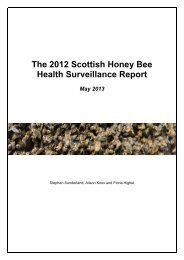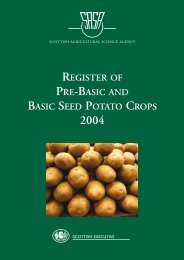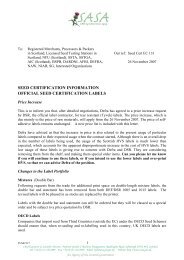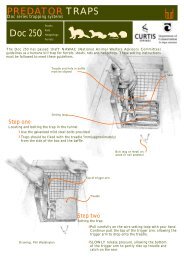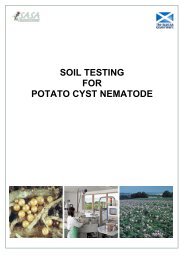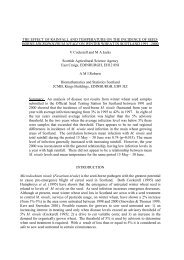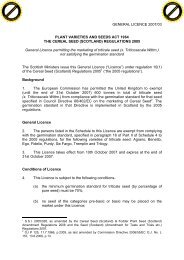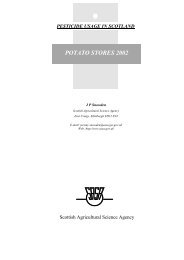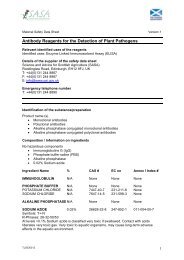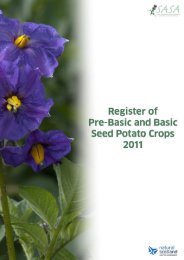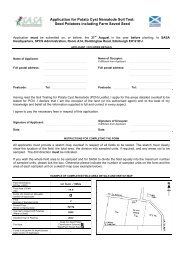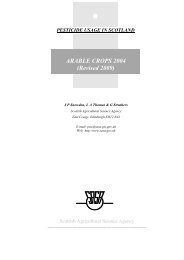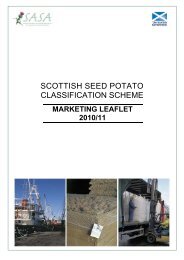Pesticide Poisoning of Animals in 2009 - A Report of ... - SASA
Pesticide Poisoning of Animals in 2009 - A Report of ... - SASA
Pesticide Poisoning of Animals in 2009 - A Report of ... - SASA
Create successful ePaper yourself
Turn your PDF publications into a flip-book with our unique Google optimized e-Paper software.
<strong>Pesticide</strong> <strong>Poison<strong>in</strong>g</strong> <strong>of</strong><strong>Animals</strong> <strong>in</strong> <strong>2009</strong>A <strong>Report</strong> <strong>of</strong> Investigations <strong>in</strong> ScotlandM J Taylor, E A Sharp, J E Watson, L M Melton and A Giela
PESTICIDE POISONING OF ANIMALS IN <strong>2009</strong>INVESTIGATIONS OF SUSPECTED INCIDENTS IN SCOTLANDM J Taylor, E A Sharp, J E Watson, L M Melton and A Giela<strong>SASA</strong>, CHEMISTRY BRANCHRodd<strong>in</strong>glaw Road, Ed<strong>in</strong>burgh EH12 9FJScience and Advice for Scottish AgricultureA Division <strong>of</strong> the Scottish GovernmentRural Payments and Inspections Directorate
© Crown copyright 2010This document is also available on the Scottish Government website:www.scotland.gov.ukISBN: 978-0-7559-9367-3Scottish GovernmentSt Andrew’s HouseEd<strong>in</strong>burghEH1 3DGPublished by the Scottish Government, June 2010APS Group ScotlandDPPAS10104 (06/10)
The Wildlife Incident Investigation Scheme (WIIS) operated <strong>in</strong> Scotland by Science andAdvice for Scottish Agriculture (<strong>SASA</strong>) Chemistry Branch <strong>in</strong>vestigates suspected poison<strong>in</strong>g<strong>of</strong> wildlife, beneficial <strong>in</strong>sects, companion animals and livestock if there is evidence to<strong>in</strong>dicate that pesticides or biocides 1 may be <strong>in</strong>volved.The scheme, together with similar schemes operat<strong>in</strong>g <strong>in</strong> England & Wales and NorthernIreland, provides a means <strong>of</strong> post-registration surveillance <strong>of</strong> pesticide use throughout theUK, so that registration may be revised if necessary. These schemes also provide a measure<strong>of</strong> the success <strong>of</strong> the pesticide registration process and help <strong>in</strong> the verification andimprovement <strong>of</strong> the risk assessments made <strong>in</strong> the registration <strong>of</strong> compounds. Incidents <strong>of</strong>approved use and <strong>of</strong> misuse can highlight problems with the approval conditions or the label<strong>in</strong>structions for a pesticide, and can provide valuable feedback <strong>in</strong>to the regulatory process.The scheme <strong>in</strong> Scotland also provides evidence that can be used by the Scottish Governmentor the police, to enforce legislation relat<strong>in</strong>g to the safe use <strong>of</strong> pesticides and the protection <strong>of</strong>food, the environment and animals.In <strong>2009</strong>, 166 <strong>in</strong>cidents (which <strong>in</strong>cluded 6 honeybee <strong>in</strong>cidents) were referred to the WIISScotland. Seven <strong>in</strong>cidents were excluded 2 , leav<strong>in</strong>g 159 <strong>in</strong>cidents accepted for further<strong>in</strong>vestigation. The cause <strong>of</strong> death or illness was determ<strong>in</strong>ed <strong>in</strong> 79 <strong>in</strong>cidents and unknown <strong>in</strong>80 <strong>in</strong>cidents. Seventy four <strong>in</strong>cidents (47% <strong>of</strong> all <strong>in</strong>cidents accepted <strong>in</strong>to the WIIS Scotland)tested positive for pesticide residues 3 .Thirty six <strong>in</strong>cidents were categorised as abuse, 5 <strong>in</strong>cidents were attributed to unspecified use,1 <strong>in</strong>cident was approved use, 2 <strong>in</strong>cidents were categorised as misuse and 1 <strong>in</strong>cident wasveter<strong>in</strong>ary use.N<strong>in</strong>eteen different pesticides 3 were identified. The <strong>in</strong>secticide, carb<strong>of</strong>uran was aga<strong>in</strong> the mostcommon pesticide detected, even though UK approval for use <strong>of</strong> products conta<strong>in</strong><strong>in</strong>g thischemical expired <strong>in</strong> 2001. Twenty two abuse <strong>in</strong>cidents <strong>in</strong>volved carb<strong>of</strong>uran.Selected samples were also screened for evidence <strong>of</strong> exposure to anticoagulant rodenticides.Residues <strong>of</strong> various anticoagulant rodenticides were detected <strong>in</strong> 42 out <strong>of</strong> 110 <strong>in</strong>cidents (i.e.38% <strong>of</strong> those <strong>in</strong>cidents selected for rodenticide screen<strong>in</strong>g). The second generationanticoagulant rodenticides, bromadiolone, brodifacoum and difenacoum were found to be themost prevalent active <strong>in</strong>gredients detected. 11 In recent years, some non-agricultural pesticides have been classified as biocides e.g. anticoagulantrodenticides. However, throughout this <strong>Report</strong> ‘pesticide’ or ‘pesticides’ will be used as the genericterm<strong>in</strong>ology.2Excluded refers to <strong>in</strong>cidents where the criteria for acceptance <strong>in</strong>to the WIIS Scotland have not been met orwhere there is no suitable material for analysis.3Includes 1 <strong>in</strong>cident that <strong>in</strong>volved ethylene glycol only.1
1. In the United K<strong>in</strong>gdom the impact <strong>of</strong> pesticide use on wildlife and other animals<strong>in</strong>clud<strong>in</strong>g honeybees, companion animals and livestock, is assessed before approval isgranted by the regulatory body. In order to protect animals, restrictions on use maybe imposed <strong>in</strong> the conditions <strong>of</strong> approval made under the Control <strong>of</strong> <strong>Pesticide</strong>sRegulations (COPR) 1986 (as amended) or the Plant Protection Products Regulations(1995), where it is thought that an unacceptable risk would arise.2. The WIIS Scotland is one <strong>of</strong> four schemes, operat<strong>in</strong>g <strong>in</strong> the United K<strong>in</strong>gdom, which<strong>in</strong>vestigates possible pesticide poison<strong>in</strong>g <strong>of</strong> animals. The WIIS Scotland is operatedby <strong>SASA</strong> Chemistry Branch on behalf <strong>of</strong> the Scottish Government’s Rural Paymentsand Inspections Directorate (RPID). The procedures for <strong>in</strong>cident <strong>in</strong>vestigation aredescribed <strong>in</strong> Appendix I.3. Incidents confirmed as <strong>in</strong>volv<strong>in</strong>g pesticides are assigned to one <strong>of</strong> the follow<strong>in</strong>gcategories:• Approved use <strong>of</strong> the product, accord<strong>in</strong>g to the specified conditions <strong>of</strong>use;• Misuse <strong>of</strong> a product, by careless, accidental or wilful failure to adhere tothe correct practice;• Abuse <strong>of</strong> a pesticide, <strong>in</strong> the form <strong>of</strong> deliberate, illegal attempts to poisonanimals;• Unspecified use, where the cause could not be assigned to one <strong>of</strong> theabove categories.• Veter<strong>in</strong>ary use, where subsequent <strong>in</strong>vestigation identifies the<strong>in</strong>volvement <strong>of</strong> a pesticide formulated as a veter<strong>in</strong>ary medic<strong>in</strong>e. Suchcases are <strong>in</strong>vestigated <strong>in</strong>cidentally rather than deliberately, and may<strong>in</strong>clude abuse, misuse, approved use, or unspecified use <strong>of</strong> the relevantcompounds.4. The results <strong>of</strong> <strong>in</strong>vestigations are ultimately reported to the Environmental Panel <strong>of</strong> theUK Advisory Committee on <strong>Pesticide</strong>s (ACP). The <strong>in</strong>formation provided may result<strong>in</strong> a re-evaluation <strong>of</strong> the approvals previously granted to products, or may affect theprogress to full commercial use <strong>of</strong> products currently under provisional approval.Information from <strong>in</strong>cidents assists <strong>in</strong> the validation and improvement <strong>of</strong> the riskassessment procedures used by the regulatory body for new and exist<strong>in</strong>g compounds.5. The majority <strong>of</strong> this post-registration surveillance activity is funded by theagricultural and non-agricultural sectors <strong>of</strong> the pesticide <strong>in</strong>dustry, under the Food andEnvironment Protection Act 1985 (FEPA) and Control <strong>of</strong> <strong>Pesticide</strong>s Regulations(COPR). In cases where there is evidence to <strong>in</strong>dicate misuse or deliberate abuse <strong>of</strong> apesticide, the results <strong>of</strong> <strong>in</strong>vestigations may also lead to legal enforcement. UnderFEPA and COPR, all aspects <strong>of</strong> pesticide advertisement, sale, supply, storage and useare fully regulated. If <strong>in</strong>vestigations reveal contravention <strong>of</strong> FEPA, COPR, or other2
legislation such as the Wildlife and Countryside Act 1981 or Possession <strong>of</strong> <strong>Pesticide</strong>s(Scotland) Order 2005, then prosecution or other forms <strong>of</strong> enforcement may ensue.All activities carried out to enforce the legislation <strong>in</strong> Scotland are funded by theScottish Government.6. The WIIS Hotl<strong>in</strong>e number (freephone: 0800 321600) is routed to <strong>SASA</strong> and providesaccess for <strong>in</strong>cident notification. To prevent large numbers <strong>of</strong> dead animals be<strong>in</strong>gsubmitted and analysed, strict criteria are applied to potential <strong>in</strong>cidents prior toacceptance.Incidents are usually excluded from analysis when there is <strong>in</strong>sufficient or unsuitablesample. However, details are recorded for reference purposes.3
NUMBER OF INCIDENTS IN <strong>2009</strong>7. A total <strong>of</strong> 166 suspected poison<strong>in</strong>g <strong>in</strong>cidents were referred to the WIIS Scotlandthroughout <strong>2009</strong>. Seven <strong>in</strong>cidents were excluded from the scheme leav<strong>in</strong>g159 <strong>in</strong>cidents accepted for subsequent <strong>in</strong>vestigation by <strong>SASA</strong> Chemistry Branch(<strong>in</strong>clud<strong>in</strong>g screen<strong>in</strong>g <strong>of</strong> selected samples for residues <strong>of</strong> anticoagulant rodenticides).Figure 1 shows the number <strong>of</strong> <strong>in</strong>cidents referred to the WIIS Scotland per annums<strong>in</strong>ce 1997. <strong>Pesticide</strong>s were detected <strong>in</strong> 74 separate <strong>in</strong>cidents i.e. 47% <strong>of</strong> all <strong>in</strong>cidents<strong>in</strong>vestigated (Appendix II).Number <strong>of</strong> <strong>in</strong>cidentsreferred to the WIIS- Scotland2001901801701601501401301201101001901771751671671661581521571441351271211997 1998 1999 2000 2001 2002 2003 2004 2005 2006 2007 2008 <strong>2009</strong>YearFigure 1. Number <strong>of</strong> <strong>in</strong>cidents referred to the WIIS (Scotland) per annum (1997-<strong>2009</strong>).8. The cause <strong>of</strong> death or illness was established <strong>in</strong> 79 <strong>in</strong>cidents. Forty five <strong>of</strong> these<strong>in</strong>cidents <strong>in</strong>volved pesticides and were assigned to an appropriate WIIS category. Inthe rema<strong>in</strong><strong>in</strong>g 34 <strong>in</strong>cidents, death was concluded to be due to starvation (10), disease(6), trauma (17) or ethylene glycol (1).9. One <strong>in</strong>cident <strong>in</strong>volv<strong>in</strong>g a buzzard was attributed to the approved use <strong>of</strong> pesticides.Two <strong>in</strong>cidents <strong>in</strong>volv<strong>in</strong>g chemicals only were categorised as misuse. One <strong>in</strong>cidentwas attributed to veter<strong>in</strong>ary use. In a further 5 <strong>in</strong>cidents, no specific source <strong>of</strong> theexposure was identified and the cause <strong>of</strong> each <strong>in</strong>cident was categorised as unspecifieduse. Thirty six <strong>in</strong>cidents were categorised as abuse. A breakdown <strong>of</strong> <strong>in</strong>cidents bysample classification is provided <strong>in</strong> Table 1.4
Table 2:Identity and frequency <strong>of</strong> pesticides detected <strong>in</strong> <strong>in</strong>cidents and associatedsample types.ChemicalNumber <strong>of</strong> <strong>in</strong>cidents <strong>in</strong>which chemical wasdetectedaldicarb 1 catSample type abendiocarb 2 cat, honeybeesbrodifacoum 14 bait, buzzard, dog, otter, red kite,peregr<strong>in</strong>e falcon, tawny owlbromadiolone 26 badger, buzzard, cat, dog, magpie,peregr<strong>in</strong>e falcon, red kite, seaeagle, tawny owl, wildcatcarb<strong>of</strong>uran 22 bait, buzzard, cat, golden eagle,magpie, paraphernalia, raven, redkite, sea eaglechloralose 12 bait, buzzard, cat, chemical, crow,paraphernalia, red kite, tawny owlcoumatetralyl 3 bait, dogcyanideDDE b(dichlorodiphenyldichloroethylene)21chemicalgolden eagledifenacoum 13 bait, barn owl, buzzard, cattle, dog,otter, red kiteendr<strong>in</strong> 1 catethylene glycol 1 baitflocoumafen 1 baitisoproturon 1 buzzardmethiocarb 2 buzzard, chemical, paraphernaliamev<strong>in</strong>phos 1 bait, ravenphostox<strong>in</strong> (phosph<strong>in</strong>e) 1 chemicalstrychn<strong>in</strong>ewarfar<strong>in</strong>11chemicalcatabAn <strong>in</strong>dividual <strong>in</strong>cident may have <strong>in</strong>volved submission <strong>of</strong> multiple and several sample types anddetection <strong>of</strong> >1 pesticide.DDE is a break-down product (metabolite) <strong>of</strong> DDT.6
Table 3 conta<strong>in</strong>s details <strong>of</strong> the number and variety <strong>of</strong> species/samples tested by <strong>SASA</strong>Chemistry Branch.Table 3: Species and number <strong>of</strong> samples tested <strong>in</strong> <strong>2009</strong>.Species or sample typeNumberMammals - wildlifeBadger 1Fox 2Hedgehog 1Otter 2Squirrel - red 1Wildcat 1BirdsBuzzard 49Eagle - golden 5Eagle - sea 4Owl - barn 9Owl – short-eared 3Owl - tawny 4Peregr<strong>in</strong>e falcon 3Red kite 10Sparrowhawk 1Dove 1Goose 1Crow 3Jackdaw 1Magpie 4Raven 8Rook 3Companion <strong>Animals</strong>Cats 19Dogs 19LivestockCattle 9Beneficial InsectsHoneybees 6Miscellaneouschicken (suspected bait) 3eggs (suspected bait) 4grouse (suspected bait) 1meat and tuna (suspected bait) 1paraphernalia (e.g. knives, game bags, gloves) 117partridge (suspected bait) 1pheasant (suspected bait) 4pigeon (suspected bait) 4rabbit and hare (suspected baits) 13suspicious chemicals and substances e.g. soil, debris 24Total number <strong>of</strong> specimens tested 3427
APPROVED USE10. A buzzard was found dead on farmland <strong>in</strong> Fife. Analysis <strong>of</strong> the bird’s stomachcontent revealed that the bird had been exposed to methiocarb, the active <strong>in</strong>gredient <strong>of</strong>products used to control e.g. slugs, snails and <strong>in</strong>sects. The subsequent field<strong>in</strong>vestigations discovered that ‘Decoy’, which conta<strong>in</strong>s methiocarb, had been recentlyapplied to a field on the farm.MISUSE11. Two <strong>in</strong>cidents were categorised as ‘Misuse’. The first <strong>in</strong>cident was discovered <strong>in</strong>January <strong>2009</strong>, when a cr<strong>of</strong>ter was seen spr<strong>in</strong>kl<strong>in</strong>g a substance onto the ground. Close<strong>in</strong>spection <strong>of</strong> the circumstance revealed that the cr<strong>of</strong>ter had spr<strong>in</strong>kled ‘Townex’ ratpoison about the carcase <strong>of</strong> a partially buried sheep <strong>in</strong> order to alleviate a ‘rat’problem.ABUSEThe active <strong>in</strong>gredient <strong>of</strong> ‘Townex’ is coumatetralyl and this chemical was confirmedto be present <strong>in</strong> soil samples and the ‘Townex’ formulation.The second <strong>in</strong>cident <strong>in</strong> September <strong>2009</strong>, <strong>in</strong>volved the <strong>in</strong>correct storage <strong>of</strong> ‘Phostox<strong>in</strong>’a gass<strong>in</strong>g agent or fumigant for control <strong>of</strong> rodent or <strong>in</strong>sect pests. The ‘Phostox<strong>in</strong>’ wasdiscovered dur<strong>in</strong>g an <strong>in</strong>vestigation <strong>in</strong>to suspicious activities around West L<strong>in</strong>ton <strong>in</strong> theScottish Borders.12. In <strong>2009</strong>, thirty six <strong>in</strong>cidents were categorised as abuse. Analytical <strong>in</strong>vestigations<strong>in</strong>cluded analysis <strong>of</strong> tissue samples, digestive tract material, various chemicals andpoison<strong>in</strong>g paraphernalia (e.g. implements/tools, game bags, residues or sweep<strong>in</strong>gsfrom vehicles). As <strong>in</strong> previous years, a high proportion (61%) <strong>of</strong> abuse <strong>in</strong>cidents<strong>in</strong>volved birds <strong>of</strong> prey (Figure 2).Figure 2. Abuse <strong>of</strong> pesticides <strong>in</strong> Scotland (number <strong>of</strong> <strong>in</strong>cidents 1997 - <strong>2009</strong>).8
13. Twenty two abuse <strong>in</strong>cidents <strong>in</strong>volved birds <strong>of</strong> prey (Table 4). Four <strong>in</strong>cidents <strong>in</strong>volvedcompanion animals (all cats) and the 10 others <strong>in</strong>cluded; raven (4), magpie (1), crow(1) and suspected baits (4).Table 4: Bird <strong>of</strong> prey species that were victims <strong>of</strong> pesticide abuse <strong>in</strong> <strong>2009</strong>.Region a Incidents Buzzard Red Kite Sea Eagle Tawny Owl Golden EagleBorder 5 4 1 - - -Dumfries & Galloway 1 2 - - - -Grampian 1 1 - - - -Highland 2 1 1 - - -Strathclyde 3 5 - - - 1Tayside 10 9 2 1 1 1TOTAL 22 22 4 1 1 2a See appendix III for regional classification <strong>in</strong> Scotland.14. Eight different pesticides were detected and identified <strong>in</strong> abuse <strong>in</strong>cidents <strong>in</strong> <strong>2009</strong>. Thepesticides were aldicarb, brodifacoum, carb<strong>of</strong>uran, chloralose, cyanide, methiocarb,mev<strong>in</strong>phos and strychn<strong>in</strong>e.UNSPECIFIED USE15. Sometimes it is not possible to def<strong>in</strong>itely establish the source <strong>of</strong> a pesticide which hasbeen positively detected and is present at levels considered to pose a significant risk.Such cases are categorised as ‘Unspecified Use’ and <strong>in</strong> <strong>2009</strong>, five <strong>in</strong>cidents fell <strong>in</strong>tothis category. <strong>Animals</strong> and pesticides <strong>in</strong>volved <strong>in</strong> these <strong>in</strong>cidents are listed <strong>in</strong> Table 5.Table 5: Unspecified Use <strong>in</strong>cidents recorded <strong>in</strong> <strong>2009</strong>.Animal Region <strong>Pesticide</strong>s MonthWildcat Grampian Bromadiolone MayDog Strathclyde Brodifacoum, bromadiolone, coumatetralyl,Julydifenacoum,Honeybees Tayside Bendiocarb AugustDog Strathclyde Bromadiolone SeptemberCat Grampian Endr<strong>in</strong> DecemberVETERINARY USE16. A cat was found dead <strong>in</strong> Irv<strong>in</strong>e, Strathclyde. Residues <strong>of</strong> bendiocarb, an <strong>in</strong>secticideused to control pests that present a risk to human health e.g. ants, cockroaches orfleas, were detected <strong>in</strong> liver tissue from the cat. Subsequent <strong>in</strong>vestigations revealedthat the owner had treated the cat with a flea treatment product that conta<strong>in</strong>edbendiocarb as the active <strong>in</strong>gredient.9
17. Non-target animals are occasionally casualties <strong>of</strong> poison<strong>in</strong>g caused by wilful oraccidental non-compliance with good practice <strong>in</strong> rodenticide bait<strong>in</strong>g. Indirect orsecondary poison<strong>in</strong>g can also occur when predators or scavengers <strong>in</strong>gest rodentskilled or affected by rodenticides. The WIIS Scotland <strong>of</strong>fers a unique opportunity toprobe wider environmental contam<strong>in</strong>ation by look<strong>in</strong>g for rodenticide residues present<strong>in</strong> non-target animals that otherwise would not be available. Rout<strong>in</strong>e monitor<strong>in</strong>g <strong>of</strong>liver tissue from wild mammals, birds <strong>of</strong> prey and other animals is carried out <strong>in</strong> orderto assess the magnitude and frequency <strong>of</strong> exposure to anticoagulant rodenticides. Theresults provide an effective <strong>in</strong>dication <strong>of</strong> the non-target animals exposed toanticoagulant rodenticides.In <strong>2009</strong>, <strong>SASA</strong> Chemistry Branch tested 118 livers from a variety <strong>of</strong> animals for thepresence <strong>of</strong> residues <strong>of</strong> anticoagulant rodenticides. Residues were found <strong>in</strong> 41specimens i.e. 35% <strong>of</strong> the total number <strong>of</strong> livers tested (Table 6).Table 6:Species tested throughout <strong>2009</strong> for the presence <strong>of</strong> residues <strong>of</strong>anticoagulant rodenticides a .Species Number tested Number positiveBuzzard 43 18Eagle-Golden 4 -Eagle-Sea 3 1Peregr<strong>in</strong>e falcon 3 1Red kite 8 4Sparrowhawk 1 -Barn Owl 9 1Short-eared Owl 3 -Tawny owl 4 2Unknown owl 1 -Crow 1 -Magpie 3 1Rook 1 -Dove 1 -Goose 1 -Badger 1 1Cat 6 2Dog 12 5Fox 2 1Hedgehog 1 -Otter 2 2Wildcat 1 1Cattle 8 1TOTAL 118 41 babBrodifacoum, bromadiolone, chlorophac<strong>in</strong>one, coumatetralyl, difenacoum, diphac<strong>in</strong>one, flocoumafen& warfar<strong>in</strong>.This is the total number <strong>of</strong> specimens that tested positive from 118 livers tested. An <strong>in</strong>dividual WIIS<strong>in</strong>cident may <strong>in</strong>volve >1 specimen.10
APPENDIX IINVESTIGATION PROCEDURESThe <strong>in</strong>vestigation <strong>of</strong> suspected pesticide poison<strong>in</strong>g <strong>in</strong>cidents relies on a scheme, which allowsmembers <strong>of</strong> the public and <strong>in</strong>terested organisations to submit carcases, suspected baits orother samples for pesticide analysis. The Wildlife Incident Investigation Scheme is operated<strong>in</strong> Scotland by the Chemistry Branch at <strong>SASA</strong> on behalf <strong>of</strong> the Scottish Government.Agricultural Staff <strong>in</strong> area <strong>of</strong>fices located throughout Scotland, provide support whennecessary for field <strong>in</strong>vestigations, and also act as an additional po<strong>in</strong>t <strong>of</strong> contact fornotification <strong>of</strong> <strong>in</strong>cidents.A number <strong>of</strong> environmental and animal welfare organisations, such as the RSPB-Scotlandand the Scottish Society for the Prevention <strong>of</strong> Cruelty to <strong>Animals</strong>, play an active role <strong>in</strong> some<strong>in</strong>cident <strong>in</strong>vestigations. These bodies act not only by assist<strong>in</strong>g members <strong>of</strong> the public tonotify <strong>in</strong>cidents, but also by screen<strong>in</strong>g out <strong>in</strong>appropriate cases prior to notification.The Scottish Agricultural College (SAC) Veter<strong>in</strong>ary Service acts <strong>in</strong> partnership with thescheme, <strong>in</strong> forward<strong>in</strong>g relevant samples to <strong>SASA</strong> from potential <strong>in</strong>cidents notified <strong>in</strong>directlyvia its laboratories, and by screen<strong>in</strong>g out <strong>in</strong>cidents that are unlikely to <strong>in</strong>volve pesticides. TheLasswade Veter<strong>in</strong>ary Laboratory is used to provide specialist pathological support to <strong>SASA</strong>on wild animals and also provides an additional route <strong>in</strong>to the scheme. The post mortemexam<strong>in</strong>ations undertaken by these laboratories may identify disease, trauma, starvation orother causes <strong>of</strong> death, elim<strong>in</strong>at<strong>in</strong>g the need for expensive analytical <strong>in</strong>vestigation.As well as <strong>in</strong>vestigat<strong>in</strong>g <strong>in</strong>cidents <strong>in</strong>volv<strong>in</strong>g wildlife, the scheme covers suspected poison<strong>in</strong>g<strong>of</strong> livestock, companion animals, and honeybees, suspicious materials and substances andsuspected baits. Incidents may be rejected if they fall out with the remit <strong>of</strong> the scheme, or ifother acceptance criteria are not met.<strong>SASA</strong> makes use <strong>of</strong> various analytical techniques, methods and <strong>in</strong>strumentation to identifyand quantify s<strong>in</strong>gle or multiple pesticide-residues. Two different multi-pesticide residuemethods are currently used to determ<strong>in</strong>e and quantify:(1) Organochlor<strong>in</strong>e, organophosphorus, carbamate and pyrethroid compounds(2) Anticoagulant rodenticides.These multi-residue methods are supplemented by compound-specific (i.e. s<strong>in</strong>gle-residue)analytical methods developed for the determ<strong>in</strong>ation <strong>of</strong> chloralose, cyanide, metaldehyde,paraquat, phosph<strong>in</strong>e and strychn<strong>in</strong>e. Wherever possible, residues are confirmed us<strong>in</strong>g analternative analytical technique or measurement parameter.Field <strong>in</strong>vestigations are normally only triggered follow<strong>in</strong>g the positive detection andidentification <strong>of</strong> pesticide(s) <strong>in</strong> or on the test specimen. However, field <strong>in</strong>vestigations mayalso be <strong>in</strong>itiated if sufficient evidence <strong>of</strong> pesticide <strong>in</strong>volvement is available e.g. follow<strong>in</strong>gdirect notification or after post-mortem exam<strong>in</strong>ation.Analytical results, post-mortem f<strong>in</strong>d<strong>in</strong>gs and field <strong>in</strong>vestigation reports are collated and<strong>in</strong>terpreted by <strong>SASA</strong> Chemistry Branch <strong>in</strong> order to categorise an <strong>in</strong>cident and to determ<strong>in</strong>e11
whether residue levels detected contributed to the death or illness <strong>of</strong> the animal <strong>in</strong>volved. Insome cases, the presence <strong>of</strong> residues <strong>in</strong> association with typical post-mortem f<strong>in</strong>d<strong>in</strong>gs may beused to determ<strong>in</strong>e mortality.The results <strong>of</strong> <strong>in</strong>vestigations <strong>in</strong> Scotland are presented annually <strong>in</strong> this report series and formpart <strong>of</strong> the Advisory Committee on <strong>Pesticide</strong>s - Environmental Panel report series publishedby Defra. The regulatory body, The Chemicals Regulation Directorate, is able to assessrelevant <strong>in</strong>cident <strong>in</strong>formation for any implications for the approval status <strong>of</strong> a particularpesticide or family <strong>of</strong> pesticides. Where legal proceed<strong>in</strong>gs are used as part <strong>of</strong> enforcementaction, the evidence gathered by <strong>SASA</strong> Chemistry Branch and SG Agricultural Staff, ispresented <strong>in</strong> reports to the Procurator Fiscal Service. Police forces are active partners <strong>in</strong>counter<strong>in</strong>g pesticide abuse and frequently take the lead <strong>in</strong> <strong>in</strong>vestigations and presentation <strong>of</strong>such cases to the Procurator Fiscal.12
SUMMARY OF POSITIVE INCIDENTS - <strong>2009</strong>APPENDIX IIREF MONTH REGION PESTICIDE CATEGORY SPECIES COMMENT09002 January Tayside chloralose, bromadioloneabuse tawny owl This <strong>in</strong>cident is the subject <strong>of</strong> an ongo<strong>in</strong>g police <strong>in</strong>vestigation. Alow-level residue <strong>of</strong> bromadiolone was also detected <strong>in</strong> livertissue.09003 January Highland brodifacoum,bromadiolonetrauma red kite The post mortem exam<strong>in</strong>ation f<strong>in</strong>d<strong>in</strong>gs were <strong>in</strong>dicative <strong>of</strong> the birdhav<strong>in</strong>g died as a result <strong>of</strong> a collision with a vehicle but thepresence <strong>of</strong> a large amount <strong>of</strong> food <strong>in</strong> the stomach raised thepossibility <strong>of</strong> poison<strong>in</strong>g. However the analytical <strong>in</strong>vestigation failedto provide any evidence to implicate pesticide poison<strong>in</strong>g. Low,level residues <strong>of</strong> brodifacoum and bromadiolone were confirmed<strong>in</strong> liver tissue from the bird.09004 January Strathclyde carb<strong>of</strong>uran abuse cat This cat was found dead <strong>in</strong> an area where there is a history <strong>of</strong>cats be<strong>in</strong>g poisoned with carb<strong>of</strong>uran. The source <strong>of</strong> the chemicalis unknown.09012 January Fife methiocarb approved buzzard This buzzard was found dead on farmland. The post mortemexam<strong>in</strong>ation f<strong>in</strong>d<strong>in</strong>gs showed the bird had died <strong>in</strong> poor bodilycondition. There was mud <strong>in</strong> the talons and the stomachconta<strong>in</strong>ed soil, grit and plant material. The analytical <strong>in</strong>vestigationconfirmed the presence <strong>of</strong> a low residue <strong>of</strong> methiocarb <strong>in</strong> thestomach content material. A field <strong>in</strong>vestigation has confirmed thata methiocarb product had been applied to the crop <strong>in</strong> December2008.09013 January Lothian brodifacoum unknown buzzard Bird found dead and reported to the police. The carcase was quitedecomposed and had been scavenged by predators. The cause<strong>of</strong> death was not established at the post mortem exam<strong>in</strong>ation. Alow level residue <strong>of</strong> brodifacoum was confirmed <strong>in</strong> liver tissue.09014 February Highland bromadiolone starvation buzzard Bird found unwell; pesticide poison<strong>in</strong>g suspected. The bird was <strong>in</strong>poor condition. A large growth found <strong>in</strong> the bird's gullet may haveh<strong>in</strong>dered its ability to feed. A residue <strong>of</strong> bromadiolone wasconfirmed <strong>in</strong> liver tissue.13
REF MONTH REGION PESTICIDE CATEGORY SPECIES COMMENT09017 January Tayside bromadiolone unknown cat This cat died suddenly just after it had been outside. This<strong>in</strong>cident occurred <strong>in</strong> a rural location and the owner wasconcerned that it may have been poisoned. However, theanalytical <strong>in</strong>vestigation did not confirm that suspicion. A very low,residue <strong>of</strong> bromadiolone was identified <strong>in</strong> liver tissue.09018 January Highland coumatetralyl misuse chemical, soil,boneThis <strong>in</strong>cident is the subject <strong>of</strong> an ongo<strong>in</strong>g police <strong>in</strong>vestigation.09019 February Highland brodifacoum starvation 2 buzzards These birds were found dead <strong>in</strong> the same area with<strong>in</strong> a few days<strong>of</strong> each other. Starvation was identified as the cause <strong>of</strong> death andthe opportunity was taken to test for evidence <strong>of</strong> exposure toanticoagulant rodenticides. Low level residues <strong>of</strong> brodifacoumwere confirmed <strong>in</strong> liver tissue from each bird.09021 February Highland carb<strong>of</strong>uran abuse raven Raven found dead <strong>in</strong> a remote area. The analytical <strong>in</strong>vestigationestablished that carb<strong>of</strong>uran poison<strong>in</strong>g was responsible for thebird's death.09022 February Highland brodifacoum,bromadiolone,difenacoumtrauma red kite This red kite was found dead on a rail track. Low levelresidues <strong>of</strong> brodifacoum, bromadiolone and difenacoum havebeen found <strong>in</strong> liver tissue from the bird.09023 February Border difenacoum unknown otter This otter was found dead next to a waterway with partly<strong>in</strong>gested food around its mouth. The analytical <strong>in</strong>vestigationfailed to establish the cause <strong>of</strong> death. A low level residue <strong>of</strong>difenacoum was confirmed <strong>in</strong> liver tissue.09025 February Fife ethylene glycol other bait material This <strong>in</strong>cident is the subject <strong>of</strong> an ongo<strong>in</strong>g police <strong>in</strong>vestigation.09026 March Border carb<strong>of</strong>uran,bromadioloneabuse buzzard This <strong>in</strong>cident is the subject <strong>of</strong> an ongo<strong>in</strong>g police <strong>in</strong>vestigation. Alow level residue <strong>of</strong> bromadiolone was also detected <strong>in</strong> livertissue.09032 March Tayside chloralose abuse 2 buzzards This <strong>in</strong>cident is the subject <strong>of</strong> an ongo<strong>in</strong>g police <strong>in</strong>vestigation.09034 March Strathclyde difenacoum starvation buzzard This bird was found dead <strong>in</strong> a garden. The post mortemexam<strong>in</strong>ation f<strong>in</strong>d<strong>in</strong>gs <strong>in</strong>dicated that starvation was the likelycause <strong>of</strong> death. A very low level residue <strong>of</strong> difenacoum wasconfirmed <strong>in</strong> liver tissue.09035 March Border bromadiolone trauma buzzard The post mortem exam<strong>in</strong>ation f<strong>in</strong>d<strong>in</strong>gs were <strong>in</strong>dicative <strong>of</strong> the birdhav<strong>in</strong>g died as a result <strong>of</strong> trauma associated with a blow to thehead. A low level residue <strong>of</strong> bromadiolone was confirmed <strong>in</strong> livertissue.14
REF MONTH REGION PESTICIDE CATEGORY SPECIES COMMENT09036 March Border carb<strong>of</strong>uran, bromadioloneabuse buzzard This <strong>in</strong>cident is the subject <strong>of</strong> an ongo<strong>in</strong>g police <strong>in</strong>vestigation. Alow level residue <strong>of</strong> bromadiolone was also detected <strong>in</strong> livertissue.09037 March Strathclyde carb<strong>of</strong>uran abuse rabbit bait This <strong>in</strong>cident is the subject <strong>of</strong> an ongo<strong>in</strong>g police <strong>in</strong>vestigation.09038 March Highland chloralose abuse buzzard This <strong>in</strong>cident is the subject <strong>of</strong> an ongo<strong>in</strong>g police <strong>in</strong>vestigation.09040 March Tayside carb<strong>of</strong>uran,difenacoumabuse 2 buzzards This <strong>in</strong>cident is the subject <strong>of</strong> an ongo<strong>in</strong>g police <strong>in</strong>vestigation. Alow level residue <strong>of</strong> difenacoum was also detected <strong>in</strong> liver tissue.09044 March Strathclyde carb<strong>of</strong>uran abuse raven This <strong>in</strong>cident is the subject <strong>of</strong> an ongo<strong>in</strong>g police <strong>in</strong>vestigation.09045 March Border brodifacoum,bromadiolone,difenacoumunknown buzzard This bird was found dead near woodland. The analytical<strong>in</strong>vestigation has failed to provide any evidence to implicatepesticide poison<strong>in</strong>g with the bird's death. Low levelresidues <strong>of</strong> brodifacoum, bromadiolone and difenacoum havebeen confirmed <strong>in</strong> liver tissue from the bird.09046 April Tayside chloralose,bromadioloneabuse 3 buzzards This <strong>in</strong>cident is the subject <strong>of</strong> an ongo<strong>in</strong>g police <strong>in</strong>vestigation.09049 April Strathclyde chloralose abuse crow A member <strong>of</strong> the public reported f<strong>in</strong>d<strong>in</strong>g 2 dead birds and a sickbird. One <strong>of</strong> the dead birds was collected for analysis. Thesource <strong>of</strong> the chemical is still under <strong>in</strong>vestigation.09050 April Border brodifacoum abuse rodenticidebait09051 April Strathclyde carb<strong>of</strong>uran abuse magpie, rabbitbaitThis <strong>in</strong>cident is the subject <strong>of</strong> an ongo<strong>in</strong>g police <strong>in</strong>vestigation.This <strong>in</strong>cident is the subject <strong>of</strong> an ongo<strong>in</strong>g <strong>in</strong>vestigation.09054 April Strathclyde bromadiolone disease badger Found dead; pesticide poison<strong>in</strong>g suspected. The post mortemexam<strong>in</strong>ation f<strong>in</strong>d<strong>in</strong>gs revealed evidence <strong>of</strong> tumours <strong>in</strong> thecarcase. The opportunity was taken to screen for evidence <strong>of</strong>exposure to anticoagulant rodenticides. The analysis confirmedthe presence <strong>of</strong> a low level residue <strong>of</strong> bromadiolone.09055 April Strathclyde carb<strong>of</strong>uran abuse raven This <strong>in</strong>cident is the subject <strong>of</strong> an ongo<strong>in</strong>g police <strong>in</strong>vestigation.09057 April Strathclyde difenacoum unknown cow Sudden, unexpla<strong>in</strong>ed death <strong>of</strong> farm animal. A low levelresidue <strong>of</strong> difenacoum has been confirmed <strong>in</strong> liver tissue.15
REF MONTH REGION PESTICIDE CATEGORY SPECIES COMMENT09059 April Strathclyde brodifacoum, bromadiolone,difenacoum,isoproturonunknown buzzard Found dead; pesticide poison<strong>in</strong>g suspected. The post mortemexam<strong>in</strong>ation f<strong>in</strong>d<strong>in</strong>gs showed no obvious abnormalities. Theanalytical <strong>in</strong>vestigation has confirmed the presence <strong>of</strong> low,sublethal residues <strong>of</strong> brodifacoum, bromadiolone and difenacoum<strong>in</strong> liver tissue. Low level residues <strong>of</strong> isoproturon have also beendetected <strong>in</strong> liver tissue and crop content material from thisbuzzard.09060 April Tayside chloralose,bromadiolone,difenacoumabuse buzzard Found dead; pesticide poison<strong>in</strong>g suspected. The analytical<strong>in</strong>vestigation has confirmed the presence <strong>of</strong> chloralose and lowlevel residues <strong>of</strong> bromadiolone and difenacoum <strong>in</strong> liver tissue.09062 April Strathclyde carb<strong>of</strong>uran abuse buzzard,pigeon baitThis buzzard was found dead beside the rema<strong>in</strong>s <strong>of</strong> a pigeon.The source <strong>of</strong> the carb<strong>of</strong>uran is still under <strong>in</strong>vestigation.09066 April Highland carb<strong>of</strong>uran abuse red kite This <strong>in</strong>cident is the subject <strong>of</strong> an ongo<strong>in</strong>g police <strong>in</strong>vestigation.09068 April Grampian bromadiolone unspecified wildcat A dead wildcat was found <strong>in</strong> an old cattle court that is now usedfor horses. The post mortem exam<strong>in</strong>ation f<strong>in</strong>d<strong>in</strong>gs <strong>in</strong>dicated thatanticoagulant rodenticide poison<strong>in</strong>g was the possible cause <strong>of</strong>death. A field <strong>in</strong>vestigation is underway to try to establish thesource <strong>of</strong> the chemical.09069 April Border brodifacoum abuse rodenticidebaitThis <strong>in</strong>cident is the subject <strong>of</strong> an ongo<strong>in</strong>g police <strong>in</strong>vestigation.09070 May Border aldicarb abuse cat This <strong>in</strong>cident is the subject <strong>of</strong> an ongo<strong>in</strong>g Scottish SPCA<strong>in</strong>vestigation.09071 May Border brodifacoum unknown otter Found dead next to a river. The analytical <strong>in</strong>vestigation hasidentified a low level residue <strong>of</strong> brodifacoum <strong>in</strong> liver tissuefrom the otter.09072 April Highland DDT unknown golden eagle This bird was found dead. However, no evidence <strong>of</strong> pesticidepoison<strong>in</strong>g was uncovered. A very low level residue <strong>of</strong> thepersistent organochlor<strong>in</strong>e DDE was confirmed.09073 May Lothian bromadiolone trauma buzzard There was concern that this bird might have been poisoned.However, the analytical <strong>in</strong>vestigation has only revealed thepresence <strong>of</strong> a low level residue <strong>of</strong> bromadiolone <strong>in</strong> livertissue.09074 April Tayside bromadiolone trauma white-tailedsea eagleThis eagle was found dead near to a railway l<strong>in</strong>e. The analytical<strong>in</strong>vestigation has confirmed a low level residue <strong>of</strong>bromadiolone <strong>in</strong> liver tissue from the bird.09075 May Grampian mev<strong>in</strong>phos abuse 2 ravens This <strong>in</strong>cident is the subject <strong>of</strong> an ongo<strong>in</strong>g police <strong>in</strong>vestigation.16
REF MONTH REGION PESTICIDE CATEGORY SPECIES COMMENT09078 May Strathclyde brodifacoum, bromadioloneunknown dog This dog was euthanased follow<strong>in</strong>g the onset <strong>of</strong> acutehaemorrhagic enteritis. Low level residues <strong>of</strong> brodifacoum andbromadiolone were confirmed <strong>in</strong> liver tissue from the animal.09081 May Border carb<strong>of</strong>uran,bromadioloneabuse red kite This <strong>in</strong>cident is the subject <strong>of</strong> an ongo<strong>in</strong>g police <strong>in</strong>vestigation.The analytical <strong>in</strong>vestigation has also confirmed the presence <strong>of</strong> aresidue <strong>of</strong> bromadiolone <strong>in</strong> liver tissue from the bird.09082 June Tayside chloralose abuse red kite This <strong>in</strong>cident is the subject <strong>of</strong> an ongo<strong>in</strong>g police <strong>in</strong>vestigation.09083 June Strathclyde carb<strong>of</strong>uran, abuse golden eagle This <strong>in</strong>cident is the subject <strong>of</strong> an ongo<strong>in</strong>g police <strong>in</strong>vestigation.methiocarb,strychn<strong>in</strong>e,sodium cyanide09087 June Grampian carb<strong>of</strong>uran abuse buzzard This <strong>in</strong>cident is the subject <strong>of</strong> an ongo<strong>in</strong>g police <strong>in</strong>vestigation.09090 June Border carb<strong>of</strong>uran abuse buzzard This <strong>in</strong>cident is the subject <strong>of</strong> an ongo<strong>in</strong>g police <strong>in</strong>vestigation.09093 June Dumfries & Gallowaybrodifacoum unknown red kite This was a young bird that was found dead <strong>in</strong> its nest. A low levelresidue <strong>of</strong> brodifacoum was confirmed <strong>in</strong> liver tissue.09096 June Dumfries &Gallowaydifenacoum unknown barn owl Three owl chicks found dead close to a nest. A low levelresidue <strong>of</strong> difenacoum was confirmed <strong>in</strong> liver tissue from one <strong>of</strong>the birds.09098 June Strathclyde brodifacoum,bromadiolone,coumatetralyl,difenacoumunspecified dog Farm dog stopped eat<strong>in</strong>g and became lethargic and dull prior todeath. The post mortem f<strong>in</strong>d<strong>in</strong>gs were suggestive <strong>of</strong> possibleanticoagulant rodenticide poison<strong>in</strong>g. The analytical <strong>in</strong>vestigationhas confirmed the presence <strong>of</strong> four anticoagulant rodenticides.The source <strong>of</strong> the chemicals has not been established.09100 July Grampian bromadiolonedifenacoum09103 July Tayside carb<strong>of</strong>uran,chloralose,difenacoumstarvation buzzard The post mortem exam<strong>in</strong>ation f<strong>in</strong>d<strong>in</strong>gs <strong>in</strong>dicated that starvationwas the likely cause <strong>of</strong> death <strong>in</strong> this <strong>in</strong>cident. Low levelresidues <strong>of</strong> bromadiolone and difenacoum were confirmed <strong>in</strong>liver tissue.abuse golden eagle This <strong>in</strong>cident is the subject <strong>of</strong> an ongo<strong>in</strong>g police <strong>in</strong>vestigation.09108 August Highland coumatetralyl unknown dog This dog collapsed after a period <strong>of</strong> repeated vomit<strong>in</strong>g. A verylow level residue <strong>of</strong> coumatetralyl was confirmed <strong>in</strong> liver tissuefrom the dog. However, <strong>in</strong> the absence <strong>of</strong> any specific postmortem exam<strong>in</strong>ation f<strong>in</strong>d<strong>in</strong>gs anticoagulant rodenticide poison<strong>in</strong>gwas not thought to be the cause <strong>of</strong> death.17
REF MONTH REGION PESTICIDE CATEGORY SPECIES COMMENT09109 August Tayside bromadiolone, difenacoumunknown buzzard This bird was thought to have died from pesticide poison<strong>in</strong>g.However, only low level residues <strong>of</strong> bromadiolone anddifenacoum have been detected <strong>in</strong> liver tissue from the buzzard.09110 August Tayside carb<strong>of</strong>uran abuse white-tailedsea eagleThis <strong>in</strong>cident is the subject <strong>of</strong> an ongo<strong>in</strong>g police <strong>in</strong>vestigation.09113 August Strathclyde chloralose abuse cat This <strong>in</strong>cident is the subject <strong>of</strong> an ongo<strong>in</strong>g police <strong>in</strong>vestigation.09117 August Tayside carb<strong>of</strong>uranchloraloseabuse buzzard This <strong>in</strong>cident is the subject <strong>of</strong> an ongo<strong>in</strong>g police <strong>in</strong>vestigation.09120 September Border carb<strong>of</strong>uran abuse buzzard This <strong>in</strong>cident is the subject <strong>of</strong> an ongo<strong>in</strong>g police <strong>in</strong>vestigation.09122 September Lothian brodifacoum,flocoumafenunknown tawny owl There was concern that this bird had died form pesticidepoison<strong>in</strong>g. However, only low level residues <strong>of</strong> brodifacoum andflocoumafen have been detected <strong>in</strong> liver tissue.09123 September Central bromadiolone unknown 3 magpies,rook09124 September Border alum<strong>in</strong>iumphosphideThese birds were found <strong>in</strong> gardens, alive but look<strong>in</strong>g concussed.There was concern that they may have been poisoned. Theanalytical <strong>in</strong>vestigation has confirmed the presence <strong>of</strong> a residue <strong>of</strong>bromadiolone <strong>in</strong> liver tissue from one <strong>of</strong> the magpies.misuse chemical This <strong>in</strong>cident is the subject <strong>of</strong> an ongo<strong>in</strong>g police and ScottishSPCA <strong>in</strong>vestigation.09126 September Strathclyde carb<strong>of</strong>uran abuse 2 cats This <strong>in</strong>cident is be<strong>in</strong>g <strong>in</strong>vestigated by the Scottish SPCA.09127 September Strathclyde bromadiolone unspecified dog Sudden, unexpla<strong>in</strong>ed death <strong>of</strong> a dog. The analytical<strong>in</strong>vestigation has confirmed the presence <strong>of</strong> a low residue <strong>of</strong>bromadiolone. The presence <strong>of</strong> this residue and strong postmortem evidence suggest anticoagulant rodenticide poison<strong>in</strong>g asthe cause <strong>of</strong> death.09128 September Strathclyde bromadiolone unknown dog This dog was seen eat<strong>in</strong>g someth<strong>in</strong>g that had been thrown <strong>in</strong>tothe garden. The dog was ill for 2 days, then became comatoseand died. Only a very low level residue <strong>of</strong> bromadiolone wasconfirmed <strong>in</strong> liver tissue.09133 October Grampian chloralose abuse 2 egg baits This <strong>in</strong>cident is the subject <strong>of</strong> an ongo<strong>in</strong>g police <strong>in</strong>vestigation.09138 October Central bromadiolone,brodifacoum09142 October Strathclyde chloralose,sodium cyanideunknown peregr<strong>in</strong>efalconabuse buzzard, rabbitbaitThis peregr<strong>in</strong>e falcon was found alive <strong>in</strong> a park but diedovernight. There was concern that it may have been poisoned.However, the analytical <strong>in</strong>vestigation only revealed low levelresidues <strong>of</strong> bromadiolone and brodifacoum <strong>in</strong> liver tissues fromthe bird.This <strong>in</strong>cident is be<strong>in</strong>g <strong>in</strong>vestigated by the Scottish SPCA.18
REF MONTH REGION PESTICIDE CATEGORY SPECIES COMMENT09143 October Tayside carb<strong>of</strong>uran abuse red kite This <strong>in</strong>cident is the subject <strong>of</strong> an ongo<strong>in</strong>g police <strong>in</strong>vestigation.09145 October Strathclyde bendiocarb veter<strong>in</strong>ary cat This cat was found dead and the owner, concerned that it mayhave been poisoned, contacted the Scottish SPCA. Analysisrevealed a residue <strong>of</strong> bendiocarb <strong>in</strong> liver tissue from the cat. TheScottish SPCA <strong>in</strong>dicated that the owner may have used a fleatreatment conta<strong>in</strong><strong>in</strong>g bendiocarb. The identity <strong>of</strong> the product hasstill to be established.09147 October Dumfries &Galloway09152 December Grampian endr<strong>in</strong>,warfar<strong>in</strong>carb<strong>of</strong>uran abuse 2 buzzards This <strong>in</strong>cident is the subject <strong>of</strong> an ongo<strong>in</strong>g police <strong>in</strong>vestigation.unspecified cat This farm cat was found dead. Another cat from the same farmhad been found dead the previous day and the owner wasconcerned that they may have been poisoned. The analytical<strong>in</strong>vestigation has revealed residues <strong>of</strong> the organochlor<strong>in</strong>e<strong>in</strong>secticide endr<strong>in</strong> <strong>in</strong> samples from the cat. A field <strong>in</strong>vestigation,undertaken by SGRPID staff, has failed to establish the source<strong>of</strong> the chemical. A very low level residue <strong>of</strong> the anticoagulantrodenticide warfar<strong>in</strong> has also been detected <strong>in</strong> liver tissue fromthis animal.09153 December Highland bromadiolone unknown buzzard This was a young buzzard that was observed stagger<strong>in</strong>g andbe<strong>in</strong>g non-responsive to pass<strong>in</strong>g traffic prior to collaps<strong>in</strong>g. Thef<strong>in</strong>der suspected that it may have been the victim <strong>of</strong> poison<strong>in</strong>g.However, the analytical <strong>in</strong>vestigation failed to provide anyevidence to implicate pesticide poison<strong>in</strong>g. A low level residue <strong>of</strong>bromadiolone was confirmed <strong>in</strong> liver tissue from the buzzard.B0609 August Tayside Bendiocarb unspecified honeybees Dead and dy<strong>in</strong>g bees found on the land<strong>in</strong>g board and on theground <strong>in</strong> front <strong>of</strong> two hives. The analytical <strong>in</strong>vestigation hasconfirmed the presence <strong>of</strong> a residue <strong>of</strong> bendiocarb <strong>in</strong> the sample<strong>of</strong> bees tested. The source <strong>of</strong> the bendiocarb has not beenestablished but exposure to this compound usually occurs throughits use as a feral bee or wasp control treatment.19
APPENDIX IIIREGIONS IN SCOTLAND USED TO CLASSIFY INCIDENTS20
© Crown copyright 2010This document is also available on the Scottish Government website:www.scotland.gov.ukISBN: 978-0-7559-9367-3Scottish GovernmentSt Andrew’s HouseEd<strong>in</strong>burghEH1 3DGPublished by the Scottish Government, June 2010APS Group ScotlandDPPAS10104 (06/10)w w w . s c o t l a n d . g o v . u k



